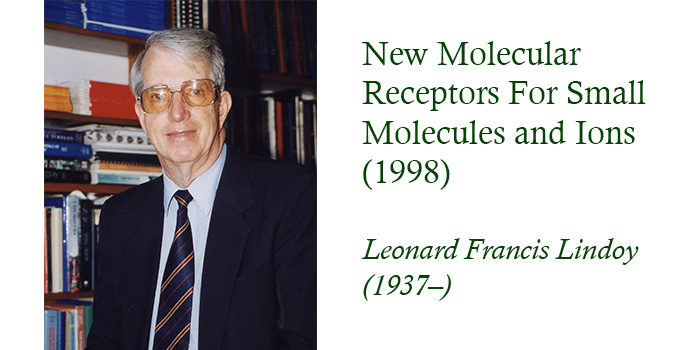31: New Molecular Receptors for Small Molecules and Ions (1998)
Abstract
Liversidge Research Lecture delivered before The Royal Society of New South Wales at Sydney University, 1st July, 1998. Reproduced by permission of the Royal Society of New South Wales from J. Proc. Roy. Soc. N.S.W., 1998, 131, 65-75.
"New macrocyclic and cage-like receptors have been synthesised. The host-guest complexation behaviour of these species with metal cations and, in one instance, organic guests has been investigated using a range of physical and computational techniques. Emphasis in these studies has been given to the development of systems showing selective host-guest complexation behaviour."
References
Adam, K.R., Arshad, S.P.H., Baldwin, D.S., Duckworth, P.A., Leong, A.J., Lindoy, L.F., McCool, B.J., McPartlin, M.,Tailor, B.A. and Tasker, P.A., 1994. Structure function relationships in the interaction of zinc(II) and cadmium(II) with an extended range of 17- to 19-membered macrocycles incorporating oxygen, nitrogen and sulfur donor atoms. Inorganic Chemistry, 33, 1194-1200 and references therein.
Adam, K.R., Atkinson, I.M., Lindoy, L.F., Matthews, O.A., Meehan, G.V., Kim, J., Svenstrup, N.S. and Raciti, F., 1998. Unpublished work.
Adam, K.R., Baldwin, D.S., Bashall, A., Lindoy, L.F., McPartlin, M. and Powell, H.R., 1994. Metal-ion recognition. Donor set control of silver(I)/lead(II) discrimination using mixed-donor macrocyclic ligands. Journal of the Chemical Society, Dalton Transactions, 1994, 237-238.
Adam, K.R., Dancey, K.P., Leong, A.J., Lindoy, L.F., McCool, B.J., McPartlin, M. and Tasker, P.A., 1988. Metal-ion recognition. 2. Structural dislocation behavior in the interaction of zinc(II) and cadmium(II) with a series of O2N3-donor macrocycles. Journal of the American Chemical Society, 110, 8471-8477.
Adam, K.R., Leong, A.J., Lindoy, L.F. and Anderegg, G., 1988. Studies involving mixed-donor macrocyclic ligands. A comparative study of the influence of medium effects on the stabilities of complexes of Co(II), Ni(II), and Cu(II) with 14- to 16-membered O2N2-donor macrocycles. Journal of the Chemical Society, Dalton Transactions, 1733-1735 and references therein.
Adam, K.R. and Lindoy, L.F., 1992. Computer modelling of metal-containing macrocyclic ligand systems - the present and the future. Chapter in "Crown Compounds: Towards Future Applications", Ed. S.R. Cooper, 1992, VCH, Weinheim, Germany, 69-79.
Ahearn, M., Kim, J., Leong, A.J., Lindoy, L.F., Matthews, O.A. and Meehan, G.V., 1996. Metal-ion recognition. The interaction of copper(II), silver(I) and lead(II) with 22-membered macrocycles incorporating O4N2-, O2S2N2- and S4N2-donor sets. Journal of the Chemical Society, Dalton Transactions, 3591-3594 and references therein.
Ahrland, S., Chatt, J. and Davies, N.R., 1958. The relative affinities of ligand atoms for acceptor molecules and ions. Quarterly Reviews, 12, 265-267.
Ahrland, S., 1996. The relative affinities of ligand atoms for acceptor molecules and ions: a long story revisited. Coordination Chemistry Reviews, 154, 13-18 and references therein.
Atkinson, I.M., Carroll, A.R., Janssen, R.J.A., Lindoy, L.F., Matthews, O.A. and Meehan, G.V., 1997. New large cage receptors. An example of selective phloroglucinol binding. Journal of the Chemical Society, Perkin Transactions 1, 295-301.
Atkinson, I.M., Groth, A.M., Lindoy, L.F., Mathews, O.A. and Meehan, G.V., 1996. New cage and linked macrocyclic systems for metal ion and small molecule binding. Pure and Applied Chemistry, 68, 1231-1236.
Atkinson, I.M. and Lindoy, L.F., 1998. Unpublished work.
Atkinson, I.M., Lindoy, L.F., Matthews, O.A., Meehan, G.V., Sobolev, A.N. and White, A.H., 1994. New macrocyclic ligands. V. Synthetic, crystallographic and computational studies of a new N2O6-heteroatom cage. Australian Journal of Chemistry, 47, 1155-1162.
Golub, G., Cohen, H., Paoletti, P., Bencini, A., Messori, L., Bertini, I. and Meyerstein, D., 1995. Use of hydrophobic ligands for the stabilization of low-valent transition metal complexes. 1. The effect of N-methylation of linear tetraaza-alkane ligands on the properties of their copper complexes. Journal of the American Chemical Society, 117, 8353-8361.
Irving, H. and Williams, R.J.P., 1953. The stability of transition-metal complexes. Journal of the Chemical Society, 3192-3210.
Izatt, R.M., Pawlak, K., Bradshaw, J.S. Bruening, R.L., 1991. Thermodynamic and kinetic data for macrocycle interaction with cations and anions. Chemical Reviews, 91, 1721-2085.
Kallert, U. and Mattes, R., 1991. X-ray crystal structures of the copper(II), nickel(II) and silver(I) complexes of a 17-membered dibenzo macrocycle with a N3S2 donor set. Inorganic Chimica Acta, 180, 263-269.
Kallert, U. and Mattes, R., 1992. Preparation and structures of the nickel(II) and silver(I) complexes of a 17-membered dibenzo macrocycle with an N2S3 donor set. Polyhedron, 11, 617-621.
Lindoy, L.F., 1989. The chemistry of macrocyclic ligand complexes. Cambridge University Press, Cambridge, U.K., 1-269.
Martell, A.E., Hancock, R.D., Motekaitis, R.J., 1994. Factors affecting stabilities of chelate, macrocyclic and macrobicyclic complexes in solution. Coordination Chemical Reviews, 133, 39-65.
Mellor D.P. and Maley, L., 1947. Stability constants of internal complexes. Nature, 1947, 159, 370.
Pearson, R.G., 1990. Hard and Soft Acids and Bases - The evolution of a chemical concept. Coordination Chemistry Reviews, 100, 403-425.
Whitesides, G.M., Simanek, E.E., Mathias, J.P., Seto, C.T., Chin, D.N., Mammen, M., and Gordon, D.M, 1995. Noncovalent synthesis: using physical-organic chemistry to make aggregates. Accounts of Chemical Research, 28, 37-44.
White, A.H. and Skelton, B.W., 1998. Unpublished work.

